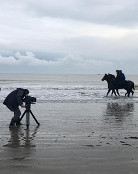Donn's Articles » Racing set for re-start
Racing set for re-start
There is depth to the document that Horse Racing Ireland have produced on the measures that have to be taken when racing in Ireland re-starts on 8th June. Protocols for race meetings behind closed doors in the context of the Covid-19 pandemic, they’ve called it.
There is the high-level stuff that you would expect, general hand hygiene and coughing etiquette and social distancing measures, as well as the racecourse’s responsibilities, the areas that need to be cleaned and disinfected prior to and during each race meeting, the weigh room, the stewards’ room, the medical room, the judge’s room. And there is the detail, Perspex screens for the clerk of the scales, Perspex screens for valets, a one-way system in weigh rooms, a designated isolation room at every racecourse, starting stalls to be disinfected after each race, road quality spray paint (two colours) in the stables complex to mark social distancing bays.
Everything pared back. No paying public, no caterers, no bookmakers, no Tote. Only essential staff. A jockey for each horse, as well as a groom and a trainer or his or her representative. Only one representative. If your presence is not essential, you are not allowed in. Even the horses’ owners are not permitted to go to the races to see their horses race.
The pre-racing health checks are new. Every person who falls into one of the ‘permitted’ categories and who is intending to go racing must fill in a detailed questionnaire two days before they go racing for the first time, and another shorter questionnaire the day before they go racing, every time they intend to go racing.
The health screening check-in is new too. Once a person has filled in the questionnaires satisfactorily, they are issued with a barcode, which is checked at the entrance to the racecourse. That’s Station 1. Once that’s all in order, they move on to Station 2, temperature screening. If they pass that, they are allowed entry and given a wristband, coloured to denote the areas to which they have access within the racecourse.
It may seem like the level of detail is over the top, 77 pages of detail, but it isn’t, according to Dr Jennifer Pugh, Senior Medical Officer with the Irish Horseracing Regulatory Board. It was important to delve into the minutiae in order present the parameters within which racing could re-start safely, and the measures that needed to be adopted.
It is a two-pronged approach to safety. Firstly, employ measures to ensure that the people who are going to the racecourse do not have Covid-19. That’s the job of the questionnaires and the health screening. Mitigate that risk. And secondly, implement initiatives to ensure that nobody who leaves the racecourse at the end of the day fits the description of ‘close contact’ with anyone else who leaves the racecourse at the end of the day.
“We learned an awful lot from the 10 meetings that we staged behind closed doors back in March,” says Dr Pugh. “We learned what worked well, what didn’t work so well, where the pinch points were. There are lots of differences between the procedures then and the procedures that we have in place now. We didn’t have health screening then, for example, and that is a hugely important part of the protocols that we have in place now. Measures to ensure that the people who are going to the races are healthy.”
In common with just about every other industry in the country, the racing and breeding industries are suffering during the pandemic. For an industry that directly or indirectly employs an estimated 29,000 people, racing is the shop window, the foundation on which the industry is built. Trainers, jockeys, breeders, farriers, stud farms, bookmakers, pinhookers, stable staff, they are all dependent on horse racing. Stop racing and you turn off the valve.
As a sport, racing is lucky in that it is a non-contact sport in which social distancing can largely be maintained. There are no scrums, no shoulders, no tackles. It is an outdoor pursuit that takes place on wide open spaces. And racehorses have continued to train during closure, so riders and trainers and staff are used to abiding by the rules of social distancing in the workplace.
France is back racing, Germany is back racing, Hong Kong never stopped racing. It is imperative that racing in Ireland proves now that it can operate effectively and safely within the protocols.
“We need 100% commitment from all stakeholders,’ says Dr Pugh. “Everyone needs to be honest, everyone needs to do what they are being asked to do. But I don’t anticipate any problems with that. Everybody knows how important it is. The government has given us a chance, it’s a privilege that we will be back racing. We have one shot at this and we need to make it work.”
© The Sunday Times, 31st May 2020


 Follow Donn
Follow Donn